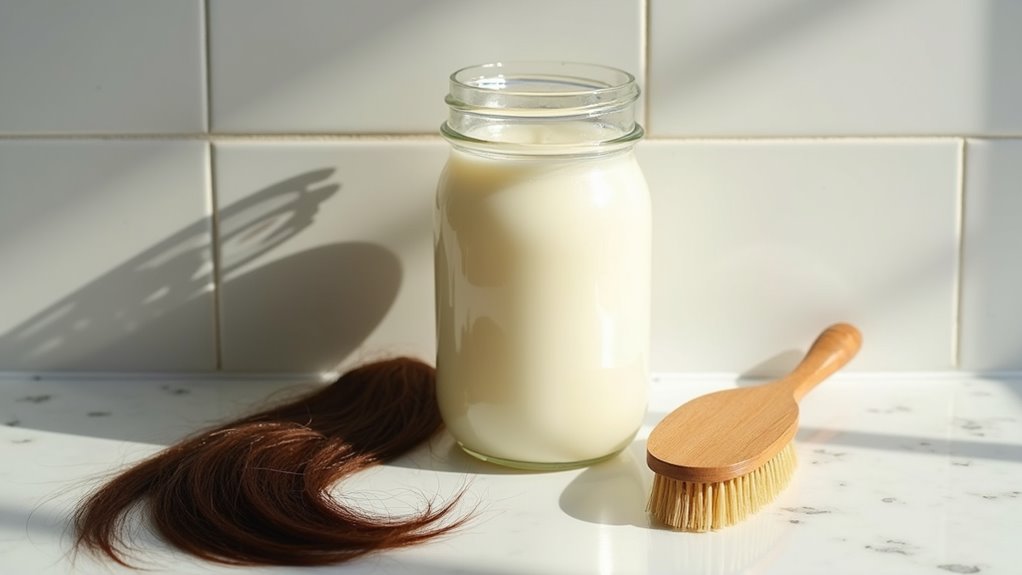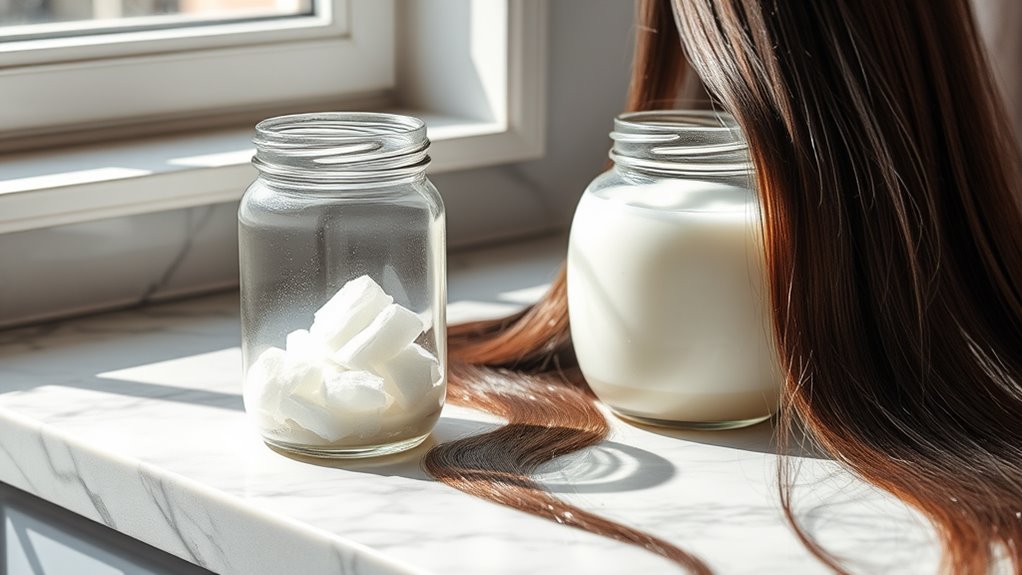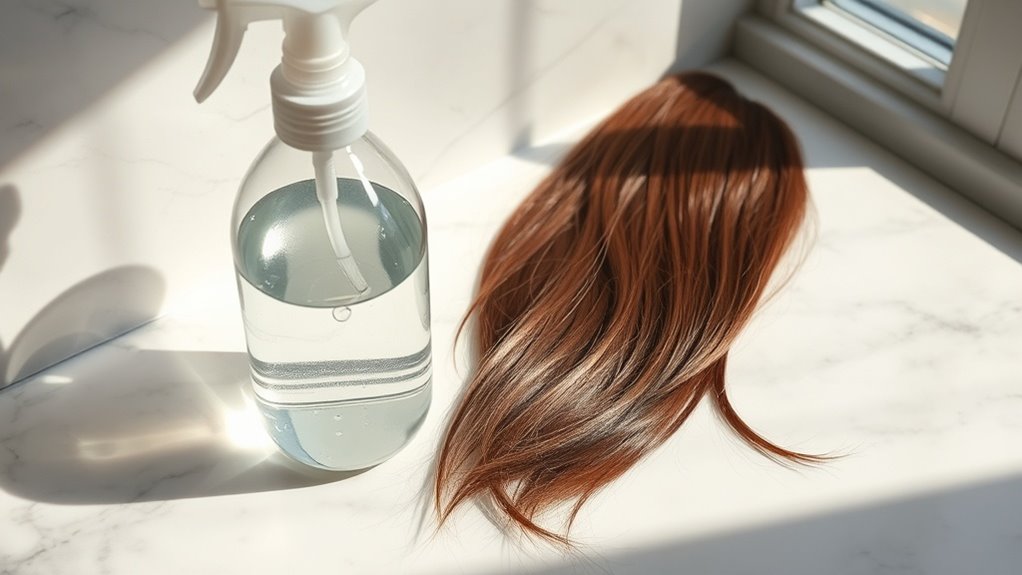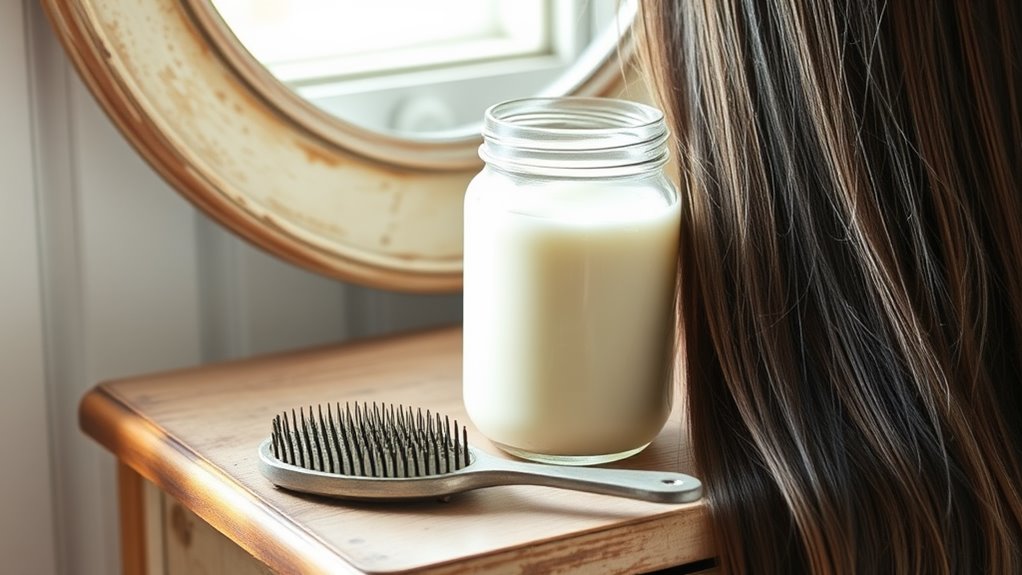The Coconut Oil Hair Mask That Saved My Split Ends
You’ll transform damaged, splitting hair into smooth, healthy locks with this simple yet powerful coconut oil hair mask. Mix 2 tablespoons of melted unrefined coconut oil with 1 tablespoon of a secondary oil like argan or jojoba. Apply to dry hair, focusing on mid-lengths and ends, then cover with a shower cap for 30 minutes before shampooing. Weekly treatments will reveal visibly stronger, shinier strands – and there’s even more to discover about this game-changing treatment.
My Hair Struggle: The Battle With Split Ends
When your hair starts showing those telltale signs of damage – frayed ends, dryness, and that dreaded splitting up the shaft – it’s time to take action.
You’ve probably tried countless products promising to repair your split ends, only to find yourself still struggling with brittle, lifeless strands that seem beyond repair.
Before discovering the power of a coconut oil hair mask, you might’ve resorted to frequent trims, which only provided temporary relief.
The constant heat styling, chemical treatments, and environmental stressors left your hair vulnerable, creating a frustrating cycle of damage that seemed impossible to break.
The rich content of lauric acid compounds in coconut oil naturally fights scalp bacteria while deeply nourishing damaged strands.
Why Coconut Oil Works Wonders for Hair
You’ll be amazed at how coconut oil’s deep moisturizing properties can transform your dry, brittle strands into silky, manageable hair.
The oil’s unique molecular structure prevents protein loss by penetrating deep into the hair shaft, protecting your locks from damage and breakage.
Beyond just helping your hair, coconut oil nourishes your scalp with antimicrobial and anti-inflammatory properties that promote overall hair health.
Rich in medium-chain fatty acids, coconut oil forms a protective barrier that maintains optimal moisture balance while strengthening hair from within.
Deep Moisturizing Properties
Because coconut oil contains medium-chain fatty acids that penetrate deep into the hair shaft, it’s uniquely effective at moisturizing hair from within.
This natural oil’s molecular structure allows it to seal moisture into your strands while preventing protein loss, making it superior to other oils for deep conditioning.
-
Lauric acid, the primary fatty acid in coconut oil, easily penetrates the hair cuticle and cortex
-
The oil’s saturated fat content creates a protective barrier that locks in hydration for up to 8 hours
-
Its high concentration of vitamin E and antioxidants helps repair damaged hair while maintaining moisture balance
Protein Loss Prevention
While many hair treatments focus solely on moisturizing, coconut oil stands out for its remarkable ability to prevent protein loss in your hair strands.
Its unique molecular structure allows it to penetrate deep into the hair shaft, protecting essential proteins like keratin from washing away during shampooing and styling.
You’ll notice the difference when you regularly apply coconut oil to your hair before washing.
The oil’s lauric acid bonds with hair proteins, creating a protective barrier that shields your strands from hygral fatigue – the repeated swelling and drying that typically leads to weakness and breakage.
This protein-preserving action keeps your hair stronger, more resilient, and healthier long-term.
Scalp Health Benefits
Beyond protecting your hair’s protein structure, coconut oil offers remarkable benefits for scalp health.
Its natural antimicrobial properties fight against common scalp issues while nourishing your skin cells at the deepest level.
-
The medium-chain fatty acids in coconut oil effectively combat dandruff-causing fungi and bacteria, helping you maintain a clean, flake-free scalp.
-
Its anti-inflammatory properties soothe irritation and reduce redness, making it perfect for sensitive or itchy scalps.
-
The oil’s rich nutrients stimulate blood circulation when massaged into your scalp, promoting healthier hair follicles and potential growth.
Essential Ingredients for the Perfect Hair Mask
You’ll want to start with pure, unrefined coconut oil as your base ingredient, which can be enhanced with complementary natural oils like argan, jojoba, or sweet almond oil for maximum hair benefits.
For the perfect DIY hair mask blend, combine 2 tablespoons of melted coconut oil with 1 tablespoon of your chosen secondary oil, creating a rich mixture that’s ideal for shoulder-length hair.
If you’re looking to boost the mask’s nourishing properties, you can incorporate a teaspoon of vitamin E oil or a few drops of rosemary essential oil into your blend.
The antimicrobial properties of coconut oil help combat scalp infections while nourishing your hair.
Best Natural Oil Combinations
Although coconut oil works wonders on its own, combining it with other natural oils can create a powerhouse hair mask that targets multiple concerns simultaneously.
You’ll experience enhanced benefits when you blend these complementary oils with your coconut base.
-
Mix argan oil to tame frizz and add shine while protecting against heat damage.
-
Add castor oil to stimulate growth and strengthen your hair follicles from root to tip.
-
Blend in jojoba oil to balance scalp oil production and deeply moisturize without weighing down your strands.
These combinations work synergistically to transform your hair’s health and appearance.
Easy Measurements and Portions
Creating the perfect coconut oil hair mask starts with precise measurements to ensure optimal results.
You’ll need 2 tablespoons of virgin coconut oil as your base, combined with 1 tablespoon of honey. For dry, damaged hair, add 1 teaspoon of vitamin E oil. If you’re dealing with scalp issues, incorporate 5 drops of tea tree oil. For extra nourishment, mix in 1 tablespoon of aloe vera gel.
These proportions work perfectly for shoulder-length hair – double the measurements for longer locks, or halve them for shorter styles.
Step-by-Step Mask Application Guide
The proper application of a coconut oil hair mask requires five essential steps to achieve optimal results.
Begin with clean, damp hair that’s been gently towel-dried to remove excess moisture. Focus on sectioning your hair properly before application to ensure thorough coverage.
- Warm the coconut oil between your palms until it’s completely melted.
- Start applying from the mid-lengths to ends, gradually working your way up to the roots.
- Massage the oil into your scalp using circular motions, then distribute evenly through hair with a wide-toothed comb.
Secure your hair in a loose bun and cover with a shower cap for maximum penetration.
For enhanced nourishment, consider adding lauric acid-rich ingredients to support antimicrobial scalp health.
Best Timing and Frequency of Treatment
You’ll want to apply your coconut oil hair mask as a pre-shampoo treatment, letting it penetrate your strands for at least 30 minutes before washing.
For those with fine or normal hair types, a weekly treatment can dramatically improve your hair’s health and manageability.
If you have thick or coarse hair, you might benefit from more frequent applications, while those with oily scalps should stick to monthly treatments to avoid overwhelming their natural oil production.
Wrapping your hair in a warm towel treatment helps the coconut oil penetrate more deeply into the hair shaft for maximum nourishment.
Weekly Vs Monthly Application
While individual hair needs vary, most people achieve optimal results by applying a coconut oil hair mask once per week.
However, if you’re dealing with extremely dry or damaged hair, you might need more frequent applications.
For those with naturally oily hair, monthly treatments may be sufficient.
-
Weekly application: Perfect for normal to dry hair types, helping maintain moisture levels and prevent split ends
-
Bi-weekly application: Ideal for chemically treated or heat-styled hair that needs extra nourishment
-
Monthly application: Suitable for fine, oily hair types or as a maintenance treatment after achieving desired results
Pre-Shampoo Timing Works Best
Because coconut oil needs time to deeply penetrate the hair shaft, applying it 30 minutes to 2 hours before shampooing produces the best results.
You’ll want to avoid leaving it on overnight, as this can lead to product buildup and greasiness.
For the most effective treatment, apply the coconut oil mask to dry hair, focusing on your mid-lengths and ends.
Gently massage it into your scalp if you’re dealing with dryness or flaking.
After the designated time, shampoo thoroughly – you may need two washes to remove all the oil.
Follow with your regular conditioner.
Common Mistakes to Avoid
Getting the most from your coconut oil hair mask means steering clear of several common pitfalls that can diminish its effectiveness.
Your hair’s health depends on proper application technique and timing. Don’t let simple mistakes sabotage your results.
-
Using too much oil will make it difficult to rinse out completely, leaving your hair looking greasy and weighed down.
-
Applying the mask to wet hair prevents proper absorption, as water creates a barrier between the oil and your strands.
-
Skipping the scalp massage step reduces blood circulation and limits the mask’s ability to penetrate the hair shaft.
For maximum benefits, always apply unrefined coconut oil to ensure you’re getting the highest quality treatment for your hair.
Before and After Results
Once you’ve mastered the proper application of coconut oil hair masks, you’ll notice dramatic improvements in your hair’s appearance and health. You’ll see increased shine, reduced breakage, and enhanced manageability within the first few treatments. Medium-chain fatty acids in coconut oil penetrate deeply into hair strands for lasting results.
| Time Frame | Visual Changes | Hair Health |
|---|---|---|
| Week 1 | Less frizz | Softer texture |
| Month 1 | Visible shine | Fewer split ends |
| Month 3 | Enhanced color | Reduced breakage |
| Month 6 | Thicker appearance | Stronger strands |
Track your progress by taking photos every two weeks and noting changes in texture, shine, and thickness. You’ll find your hair becomes increasingly resilient and easier to style as treatments continue.
Additional Hair Care Tips
To maximize the benefits of your coconut oil hair mask treatments, you’ll want to incorporate complementary hair care practices into your routine. These proven techniques will help maintain your hair’s health between masks and enhance overall results.
-
Use a silk pillowcase to reduce friction while you sleep, preventing tangles and breakage that can lead to split ends.
-
Limit heat styling to twice weekly, and always apply a heat protectant product before using hot tools.
-
Trim your hair every 8-10 weeks to prevent split ends from traveling up the hair shaft.
Consider using cold-pressed coconut oil for your hair treatments, as this variety retains more beneficial compounds than processed alternatives.
Alternative Natural Ingredients
While coconut oil stands as a powerful natural hair treatment, several other kitchen-found ingredients can deliver remarkable benefits for your locks.
Try avocado for deep moisturizing, honey for shine and antibacterial properties, or aloe vera for scalp health. You’ll love egg yolks for protein-rich conditioning and olive oil for taming frizz.
For extra nourishment, mix Greek yogurt into your masks to boost protein content and add shine.
Apple cider vinegar helps balance scalp pH and removes buildup, while banana provides potassium and natural oils that strengthen hair fibers.
Expert Recommendations and Studies
Scientific research backs the traditional use of coconut oil for hair care, with multiple studies confirming its ability to penetrate hair shafts and reduce protein loss.
Hair care experts recommend using virgin coconut oil for optimal results, as it retains more beneficial compounds than refined varieties.
-
Research published in the Journal of Cosmetic Science shows coconut oil reduces protein loss in both damaged and undamaged hair.
-
Studies indicate coconut oil’s lauric acid content helps prevent hair breakage.
-
Clinical trials demonstrate that pre-wash coconut oil application provides better protection than mineral oil treatments.
You’ll find most trichologists recommend weekly treatments for best results.







